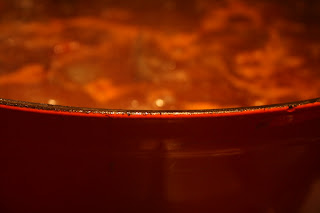I love gyoza and always order them in Japanese or Chinese restaurants. They are dumplings that can be steamed, fried or first fried and then steamed (potstickers). Popular in Asia , the Japanese version known as gyoza and the Chinese version known as jiaozi. They are, as you can imagine similar but use different filling are cooked slighly differently. They are the Asian version of the Italian's ravioli. The version we cooked was leaning towards the Japanese but I would say that we spun it a little with flavours more associated with Thai and it really worked.
We took a traditional recipe for Japanese gyoza - minced pork and cabbage being the main ingredients. We added spring onion, coriander, ginger, garlic, fish sauce and lime juice and grated lime peel. The dipping sauce was a mixture of Japanese rice wine and soy sauce although next time I would use Tamari which is the Japanese equivalent but we had run out annoyingly.
We also slightly cheated in that we had some wanton pastry in the freezer and whilst wanton pastry is different in that its slightly thicker it didn't seem to make a huge amount of difference. The most notable was the wanton skins were square and smaller and the gyoza should be made from round so you can make crescent shaped dumplings. The difference in the pastry is wanton pastry contains egg and as I said early is thicker, the remaing ingredients is water, wheat flour and salt. So ignoring that fact we went ahead as we wanted to make them anyway as an experiment as paying £6 for 4 dumplings in a restaurant was good motivation to perfect the making of these delicious dumplings.
Ingredients
1 small sweatheart cabbage
6 spring onions
3 cloves garlic
250g pork mince
2 tablespoons fish sauce
1 heaped tablespoon chopped coriander
1 lime grated peel
1 teaspoon lime juice
gyoza wrappers (although as I said we used wantons and they were fine)
1 egg white (to help stick the dumplings)
oil for frying
For the sauce
1 tablespoon Soy sauce
1 tablespoon Japanese rice wine
To start you need to finely chop and salt the cabbage with about 2 teaspoons of salt and really work into the cabbage. Good old osmosis goes into action and the pile of sweatheart cabbage is stripped of all its water and, after 20 minutes, once you have given it a good squeeze in a cloth, you are left with a ball of chopped cabbage. While this was going on you take the minced pork and add the finely chopped spring onion, chopped coriander, garlic and ginger, fish sauce and lime.
Once you have mix this up add the cabbage which will now have much of the water removed by the salt. Mix this again so that its all mixed through and now start to fill the pastry. With this amount of mixture you should be able to make around 40. Each one has around two teaspoons worth of the mixture.
Once you have finished the dumplings add them to a pan and fry them until they are brown. Some recipes say to just fry on one side - I didn't I fried both sides. You then add about 200ml of boiling water and cover the pan so that the dumplings are cooked through. You need to cook them until the water has evaporated and you are left with delicious gyoza. Admittedly mine weren't going to win the shape award but they more than made up with the flavour - awesome!
Serve straight away with the dipping sauce...







